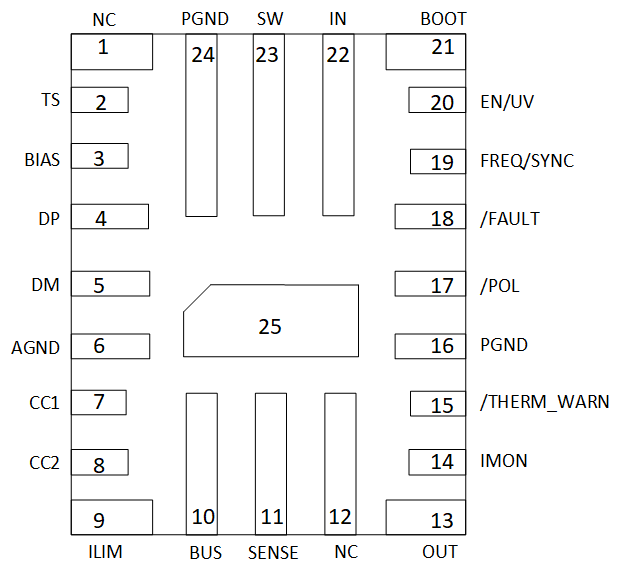SLVSFJ9 September 2021 TPS25854-Q1 , TPS25855-Q1
PRODUCTION DATA
- 1 Features
- 2 Applications
- 3 Description
- 4 Revision History
- 5 Description (Continued)
- 6 Device Comparison Table
- 7 Pin Configuration and Functions
- 8 Specifications
- 9 Parameter Measurement Information
-
10Detailed Description
- 10.1 Overview
- 10.2 Functional Block Diagram
- 10.3
Feature Description
- 10.3.1 Power Down or Undervoltage Lockout
- 10.3.2 Input Overvoltage Protection (OVP) - Continuously Monitored
- 10.3.3 Buck Converter
- 10.3.4 FREQ/SYNC
- 10.3.5 Bootstrap Voltage (BOOT)
- 10.3.6 Minimum ON-time, Minimum OFF-time
- 10.3.7 Internal Compensation
- 10.3.8 Current Limit and Short Circuit Protection
- 10.3.9 Cable Compensation
- 10.3.10 Thermal Management With Temperature Sensing (TS) and OTSD
- 10.3.11 Thermal Shutdown
- 10.3.12 FAULT Indication
- 10.3.13 USB Specification Overview
- 10.3.14 USB Type-C® Basics
- 10.3.15 USB Port Operating Modes
- 10.4 Device Functional Modes
-
11Application and Implementation
- 11.1 Application Information
- 11.2
Typical Applications
- 11.2.1 Design Requirements
- 11.2.2
Detailed Design Procedure
- 11.2.2.1 Output Voltage Setting
- 11.2.2.2 Switching Frequency
- 11.2.2.3 Inductor Selection
- 11.2.2.4 Output Capacitor Selection
- 11.2.2.5 Input Capacitor Selection
- 11.2.2.6 Bootstrap Capacitor Selection
- 11.2.2.7 Undervoltage Lockout Set-Point
- 11.2.2.8 Cable Compensation Set-Point
- 11.2.2.9 FAULT, POL, and THERM_WARN Resistor Selection
- 11.2.3 Application Curves
- 12Power Supply Recommendations
- 13Layout
- 14Device and Documentation Support
- 15Mechanical, Packaging, and Orderable Information
Package Options
Mechanical Data (Package|Pins)
- RPQ|25
Thermal pad, mechanical data (Package|Pins)
Orderable Information
7 Pin Configuration and Functions
 Figure 7-1 TPS2585x-Q1 RPQ Package25-Pin (QFN)Top View
Figure 7-1 TPS2585x-Q1 RPQ Package25-Pin (QFN)Top ViewTable 7-1 Pin Functions for TPS25854/5 RPQ
Package
| PIN | TYPE (2) | DESCRIPTION | |
|---|---|---|---|
| NAME | NO | ||
| NC | 1, 12 | A | No connection |
| TS | 2 | A | Temperature sense terminal. Connect the TS input to the NTC thermistor. |
| BIAS | 3 | P | Input of internal bias supply, must connect to the SENSE pin directly, power the internal circuit. |
| DP | 4 | A | D+ data line. Connect to the USB connector. |
| DM | 5 | A | D– data line. Connect to the USB connector. |
| AGND | 6 | P | Analog ground terminal. Connect AGND to PGND. |
| CC1 | 7 | A | Connect to Type-C CC1 pin. Analog input, output, or both. |
| CC2 | 8 | A | Connect to Type-C CC2 pin. Analog input, output, or both. |
| ILIM | 9 | A | Current limit program. Connect a resistor to set the current limit threshold. Short to GND to set the default 3.55-A current limit. |
| BUS | 10 | P | BUS Output |
| SENSE | 11 | P | Output voltage sensing, external load on this pin is strictly prohibited. Connect to the other side of the external inductor. |
| OUT | 13 | P | Output pin, provide 5.1-V voltage to power external load with maximum 200-mA capability. The voltage follows the VSENSE. |
| IMON | 14 | A | USB output current monitor. Connect a resistor to set the maximum cable comp voltage at full load current. |
| THERM_WARN | 15 | A | Thermal warning indication. Active LOW open-drain output. Asserted when voltage at the TS pin increases above the thermal warning threshold. |
| PGND | 16, 24, 25 | P | Power ground terminal, connected to the source of LS FET internally. Connect to system ground, AGND, and the ground side of CIN and COUT capacitors. Path to CIN must be as short as possible. |
| POL | 17 | A | Cable polarity indication. Active low open-drain logic output, signals which Type-C CC pin is connected to the CC line. This gives the information needed to mux the super speed lines. Asserted when the CC2 pin is connected to the CC line in cable. |
| FAULT | 18 | A | Fault indication. Active low open-drain logic output, Asserted during overcurrent or overtemperature conditions. |
| FREQ/ SYNC | 19 | A | Switching frequency program and external clock input. Connect a resistor from FREQ to GND to set the switching frequency. |
| EN/UV | 20 | A | Enable pin. Precision enable controls the regulator switching action and type-C. Do not float. High = on, Low = off. Can be tied to SENSE directly. Precision enable input allows adjustable UVLO by external resistor divider if tied to IN pin. |
| BOOT | 21 | P | Bootstrap capacitor connection. Internally, the BOOT is connected to the cathode of the booststrap diode. Connect the 0.1-μF bootstrap capacitor from SW to BOOT. |
| IN | 22 | P | Input power. Connected to external DC supply. Expected range of bypass capacitors is 1 μF to 10 μF. Connect from IN to PGND. Withstand up to 36 V without damage, but operating is suspended if VIN is above the 26-V OVP threshold. |
| SW | 23 | P | Switching output of the regulator. Internally connected to source of the HS FET and drain of the LS FET. Connect to output inductor. |
(2) A = Analog, P = Power, G = Ground.